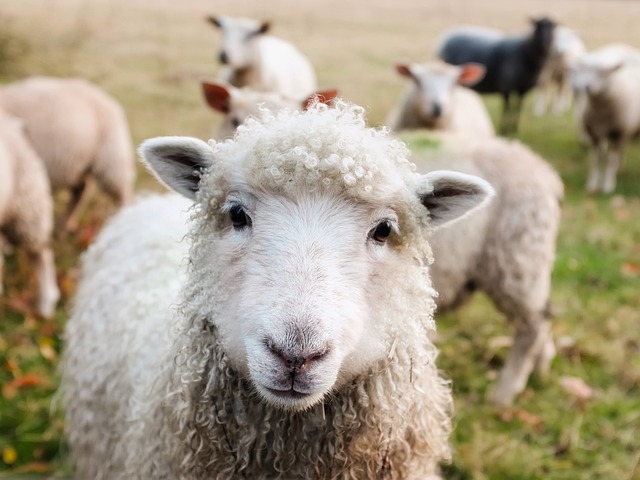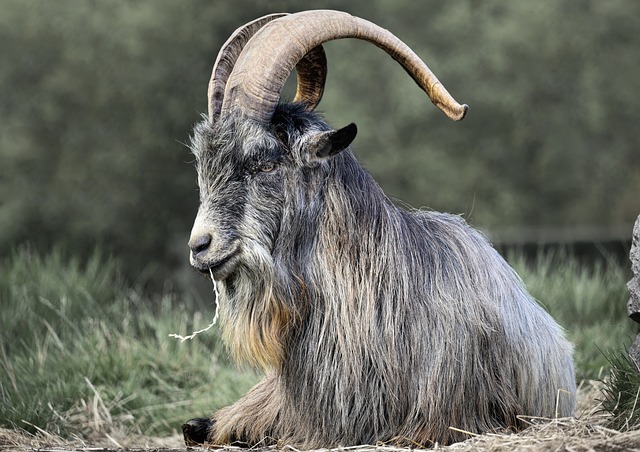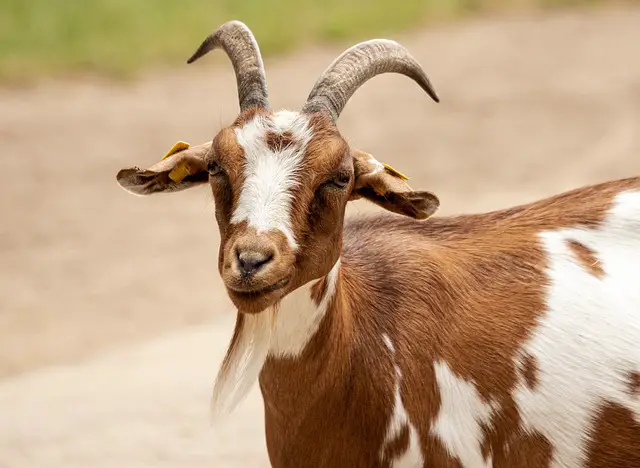Sheep typically have woolly coats and curved horns (in some breeds), while goats usually have shorter hair and straight or slightly twisted horns. Sheep tend to be larger in size compared to goats.
Sheep

One distinguishing characteristic of sheep is their distinctive appearance. They are known for their thick woolly fleece which can vary in color from white to black or even shades of brown. Their adorable faces are adorned with two floppy ears and expressive eyes that seem to radiate innocence.
But it’s not just their outward appearance that makes sheep interesting. These herbivorous grazers have a unique digestive system designed specifically to break down plant matter efficiently. With a four-chambered stomach, they can extract every ounce of nutrition from the grasses they consume, making them incredibly efficient at converting plants into energy.
In terms of behavior, sheep exhibit flocking tendencies – they prefer sticking together in groups rather than venturing off alone. This social structure provides them with safety and protection from predators lurking nearby.
Furthermore, these gentle beings possess remarkable memory skills. Studies have shown that they can recognize familiar faces among humans and other sheep even after long periods apart.
Goats

One distinctive characteristic of goats is their agility and climbing skills. They have a natural ability to navigate rocky landscapes, making them excellent climbers. Goats can often be seen perched on top of rocks or even trees! This unique trait sets them apart from sheep.
In terms of appearance, goats generally have longer, shaggier hair compared to sheep. Their coats come in a variety of colors and patterns, adding to their charm. Additionally, goats possess backward-curving horns that grow throughout their lives. However, not all goat breeds have horns; some are naturally polled (hornless).
Goats are known for being curious and independent animals. They tend to explore their surroundings more actively than sheep do. While sheep tend to flock together as a means of protection against predators, goats prefer smaller groups or even solitude.
Goats also play an important role in sustainable land management practices due to their browsing behavior. Unlike sheep that primarily graze on grasses closer to the ground level, goats excel at reaching higher vegetation such as shrubs and low tree branches.
Sheep Vs. Goats – Physical Appearance and Characteristics
Sheep
- Woolly Coat: Sheep are known for their woolly fleece, which varies in texture and color depending on the breed. Wool is a key characteristic of sheep, and it serves various purposes, from insulation to textile production.
- Horns: Some sheep breeds have horns, while others are hornless (polled). The shape and size of the horns can vary among different sheep breeds.
- Stocky Build: Sheep generally have a stocky and rectangular body shape. They are herbivores and have a complex digestive system capable of efficiently processing plant materials.
Goats
- Goatee and Beard: Many goats have a goatee (hair beneath the chin) and a beard (longer hair on the lower jaw), which are distinctive facial features not seen in sheep.
- Horns: Goats typically have horns, although some breeds are naturally polled (lack horns). Goat horns come in various shapes and sizes, and they are often used for defense or dominance.
- Lean and Agile: Compared to sheep, goats have a leaner and more agile appearance. They are excellent climbers and are known for their ability to navigate rocky terrain and steep slopes.
Sheep Vs. Goats – Behavior and Social Structures
Sheep
- Flocking Behavior: Sheep are social animals and tend to flock together. They exhibit strong flocking behavior, which provides them with safety and protection from predators.
- Hierarchy: Sheep often establish a hierarchy within the flock, with dominant individuals asserting their authority. This hierarchy can influence access to resources like food and water.
- Grazing and Foraging: Sheep are primarily grazers and feed on grasses and other low-lying vegetation. They are known for their methodical grazing behavior, cropping grass close to the ground.
Goats
- Independence: Goats are more independent and curious in their behavior compared to sheep. They often explore their environment and are more likely to venture away from the herd.
- Hierarchy and Dominance: Like sheep, goats also establish hierarchies within herds, but their dominance behaviors can be more overt. They may use headbutting and other physical displays to establish rank.
- Versatile Feeders: Goats are browsers, which means they tend to eat a wider variety of plants than sheep. They are known for their ability to consume leaves, shrubs, and even tree bark.
Image Credits
Featured Image By – minka2507 from Pixabay








